语言学
语言学概论
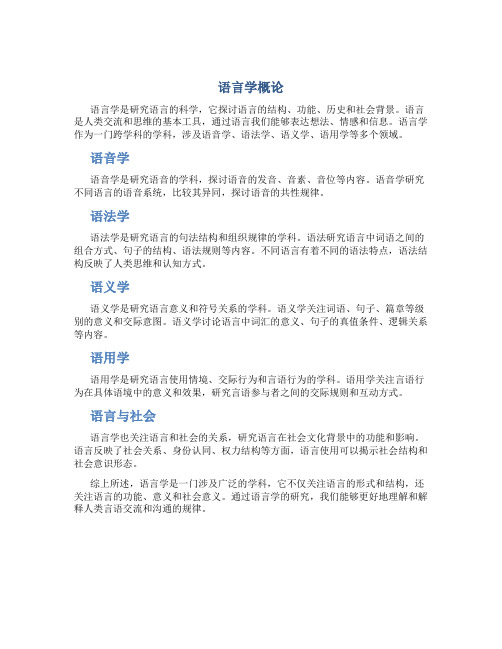
语言学概论
语言学是研究语言的科学,它探讨语言的结构、功能、历史和社会背景。
语言是人类交流和思维的基本工具,通过语言我们能够表达想法、情感和信息。
语言学作为一门跨学科的学科,涉及语音学、语法学、语义学、语用学等多个领域。
语音学
语音学是研究语音的学科,探讨语音的发音、音素、音位等内容。
语音学研究不同语言的语音系统,比较其异同,探讨语音的共性规律。
语法学
语法学是研究语言的句法结构和组织规律的学科。
语法研究语言中词语之间的组合方式、句子的结构、语法规则等内容。
不同语言有着不同的语法特点,语法结构反映了人类思维和认知方式。
语义学
语义学是研究语言意义和符号关系的学科。
语义学关注词语、句子、篇章等级别的意义和交际意图。
语义学讨论语言中词汇的意义、句子的真值条件、逻辑关系等内容。
语用学
语用学是研究语言使用情境、交际行为和言语行为的学科。
语用学关注言语行为在具体语境中的意义和效果,研究言语参与者之间的交际规则和互动方式。
语言与社会
语言学也关注语言和社会的关系,研究语言在社会文化背景中的功能和影响。
语言反映了社会关系、身份认同、权力结构等方面,语言使用可以揭示社会结构和社会意识形态。
综上所述,语言学是一门涉及广泛的学科,它不仅关注语言的形式和结构,还关注语言的功能、意义和社会意义。
通过语言学的研究,我们能够更好地理解和解释人类言语交流和沟通的规律。
语言学基础知识

语言学基础知识语言学是一门探索语言现象和语言规律的学科,它涉及语音、语义、语法、语用等多个方面,对研究和理解语言的发展和使用具有重要意义。
本文将介绍语言学的基本概念、分类及其相关理论,以帮助读者初步了解语言学的基础知识。
一、语言学的定义和概念语言学可以被定义为研究语言现象的学科,它涉及语言的结构、功能、历史、变化等多个方面。
语言是人类交流、表达思想与情感的重要工具,而语言学的目的就是通过观察、分析和解释语言的规律,帮助我们更好地理解语言的本质和运作方式。
语言学的研究对象主要包括语音、语义、语法和语用等多个方面。
语音学研究语言的音素、音节、音调等音声特征;语义学研究语言的意义和词汇的搭配规律;语法学则研究语言的句法结构和短语组织;语用学则关注语言的使用及其在特定语境中的意义。
二、语言学的分类根据研究的层面和对象的不同,语言学可以分为多个不同的分类。
以下是其中几个主要的分类。
1.应用语言学:应用语言学是指将语言学的理论和方法应用于实际语言问题的研究领域。
这包括语言教学、翻译研究、语音识别、自然语言处理等方面。
2.历史语言学:历史语言学研究语言的发展和演变。
它通过比较不同时期和地区的语言形态、语法、词汇等,揭示语言的历史变化规律。
3.形态学:形态学研究词汇的内部结构和构词规律。
它关注词的形态形式、词根、词缀等,以及它们在句中的使用方式和句法功能。
4.句法学:句法学研究句子的结构和组成。
它关注词与词之间的关系以及它们按照一定规律组合而成的短语、从句和主句等句法单位。
5.语音学:语音学研究语言的音素、音节和音调等音声特征。
它通过观察和描述语言的发音规律,揭示不同语言之间的音位差异和音变规律。
6.语义学:语义学研究语言的意义和词汇的表义关系。
它关注词语之间的意义关联和句子的语义结构,帮助我们理解语言中的暗示、隐喻和逻辑关系。
三、语言学的相关理论1. 结构主义:结构主义是20世纪初发展起来的一种语言学理论,强调语言的内在结构和规律。
语言学专业大类
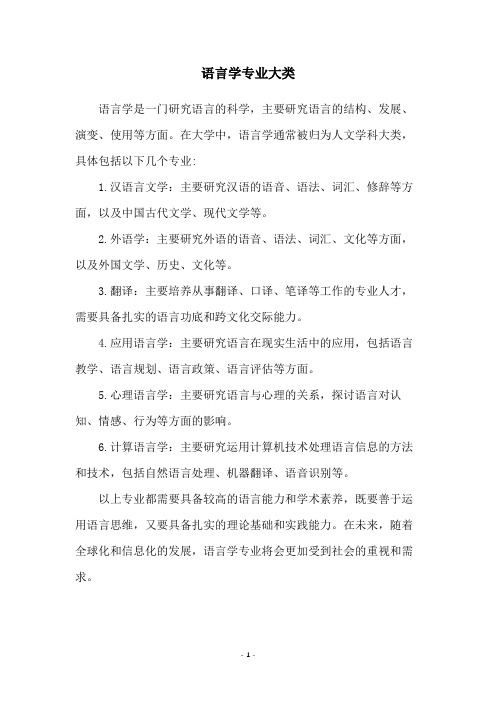
语言学专业大类
语言学是一门研究语言的科学,主要研究语言的结构、发展、演变、使用等方面。
在大学中,语言学通常被归为人文学科大类,具体包括以下几个专业:
1.汉语言文学:主要研究汉语的语音、语法、词汇、修辞等方面,以及中国古代文学、现代文学等。
2.外语学:主要研究外语的语音、语法、词汇、文化等方面,以及外国文学、历史、文化等。
3.翻译:主要培养从事翻译、口译、笔译等工作的专业人才,需要具备扎实的语言功底和跨文化交际能力。
4.应用语言学:主要研究语言在现实生活中的应用,包括语言教学、语言规划、语言政策、语言评估等方面。
5.心理语言学:主要研究语言与心理的关系,探讨语言对认知、情感、行为等方面的影响。
6.计算语言学:主要研究运用计算机技术处理语言信息的方法和技术,包括自然语言处理、机器翻译、语音识别等。
以上专业都需要具备较高的语言能力和学术素养,既要善于运用语言思维,又要具备扎实的理论基础和实践能力。
在未来,随着全球化和信息化的发展,语言学专业将会更加受到社会的重视和需求。
- 1 -。
什么是语言学?
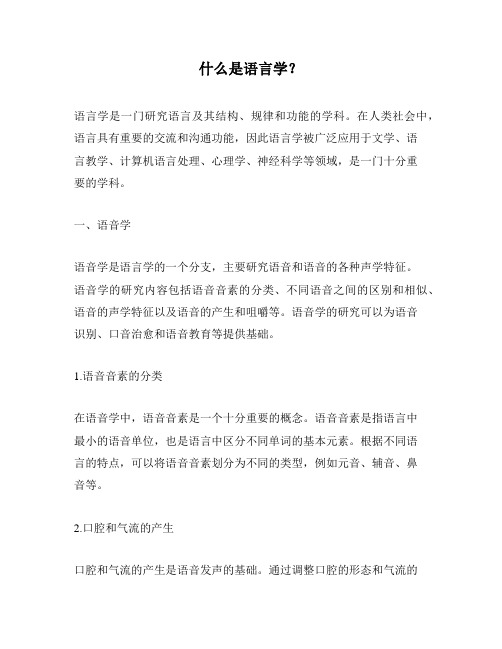
什么是语言学?语言学是一门研究语言及其结构、规律和功能的学科。
在人类社会中,语言具有重要的交流和沟通功能,因此语言学被广泛应用于文学、语言教学、计算机语言处理、心理学、神经科学等领域,是一门十分重要的学科。
一、语音学语音学是语言学的一个分支,主要研究语音和语音的各种声学特征。
语音学的研究内容包括语音音素的分类、不同语音之间的区别和相似、语音的声学特征以及语音的产生和咀嚼等。
语音学的研究可以为语音识别、口音治愈和语音教育等提供基础。
1.语音音素的分类在语音学中,语音音素是一个十分重要的概念。
语音音素是指语言中最小的语音单位,也是语言中区分不同单词的基本元素。
根据不同语言的特点,可以将语音音素划分为不同的类型,例如元音、辅音、鼻音等。
2.口腔和气流的产生口腔和气流的产生是语音发声的基础。
通过调整口腔的形态和气流的流动速度,人类可以发出各种不同的语音。
因此,语音学研究如何调整口腔的形态和气流的流动速度,以及如何在不同语言中发出完整的语音。
3.声学特征分析语音学的另一个重要任务是分析语音的声学特征。
语音具有不同的频率、幅度和相位等特征,这些特征可以用来区分不同的语音。
为了研究语音的声学特征,语音学需要采集音频数据,并通过计算机软件将音频数据转换成可视化信息。
二、语法学语法学是语言学的另一个分支,主要研究语言中的句子、短语、词汇和语言结构等。
语法学的研究可以帮助人们理解语言的构成和使用规律,对于语言教育和机器翻译等应用也有重要的意义。
1.句法分析句法分析是语法学的一个重要研究领域,主要研究句子中的词汇、短语和语法关系等。
通过对句子结构的分析,可以理解其含义,进而实现语言的交流。
句法分析的方法包括树状结构分析、依存语法分析等。
2.词法分析语言中的词汇是由若干语音、音节组成的,词法分析主要研究词汇的形态、构成和变化等规律。
通过对词汇的分析,可以理解其在不同句子中的含义和使用方法。
3.语法关系分析语法关系分析是语法学的另一个研究方向,主要研究语言的不同成分之间的关系。
语言学分类
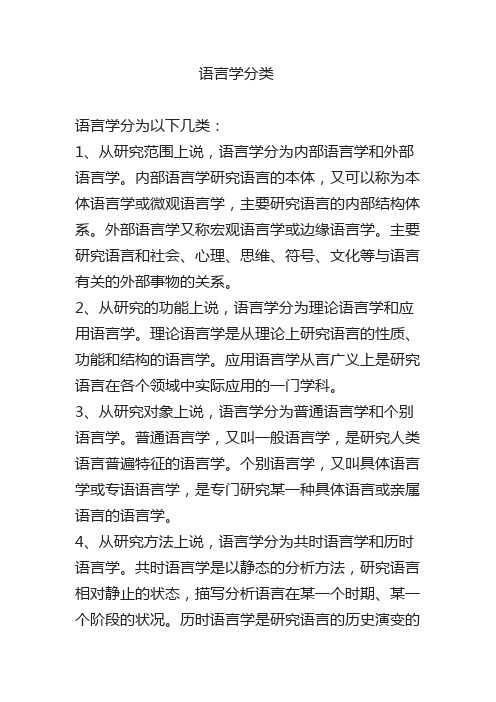
语言学分类
语言学分为以下几类:
1、从研究范围上说,语言学分为内部语言学和外部语言学。
内部语言学研究语言的本体,又可以称为本体语言学或微观语言学,主要研究语言的内部结构体系。
外部语言学又称宏观语言学或边缘语言学。
主要研究语言和社会、心理、思维、符号、文化等与语言有关的外部事物的关系。
2、从研究的功能上说,语言学分为理论语言学和应用语言学。
理论语言学是从理论上研究语言的性质、功能和结构的语言学。
应用语言学从言广义上是研究语言在各个领域中实际应用的一门学科。
3、从研究对象上说,语言学分为普通语言学和个别语言学。
普通语言学,又叫一般语言学,是研究人类语言普遍特征的语言学。
个别语言学,又叫具体语言学或专语语言学,是专门研究某一种具体语言或亲属语言的语言学。
4、从研究方法上说,语言学分为共时语言学和历时语言学。
共时语言学是以静态的分析方法,研究语言相对静止的状态,描写分析语言在某一个时期、某一个阶段的状况。
历时语言学是研究语言的历史演变的
科学。
它研究一种语言的各个结构要素在不同发展阶段的历史演变,研究语言的发展规律。
《语言学导论》课件

D
语言的要素
02
语音
01
语音的物理属性
包括音高、音长、音强和音质等,这些属性决定了语音 的音质和音色。
03
02
语音的生理机制
发音器官如声带、口腔、鼻腔等在发音过程中的作用, 以及语音的感知器官如耳朵在接收和感知语音中的作用 。
音位和音素
音位是语言中具有区别意义作用的最小语音单位,而音 素是构成音位的语音单位,包括元音和辅音。
语序灵活的语言是指一种词语之间的顺序较为灵活的语言,语法关系不完全依赖于词序。
详细描述
语序灵活的语言的词语顺序较为灵活,语法关系不完全依赖于词序,而是可以通过其他方式来表达。例如英语和 荷兰语就是典型的语序灵活的语言,它们的词语顺序较为灵活,可以通过介词、连词等虚词来表达语法关系。
04 语言的演变
深远影响。
语言与社会变迁的互动
03
语言随着社会变迁而发展变化,同时又影响着社会文化的传播
和发展。
语言的文化功能
表达情感与思想
语言是人们表达情感和思想的主要方式,通过语言表达人们的内 心世界。
传承文化
语言是文化传承的重要途径,通过语言将文化遗产传递给下一代 。
维系社会关系
语言在维系社会关系中发挥重要作用,通过语言交流加强人际关 系的纽带。
句法学
研究语言的句子结构,包括句子成分、词组结构、 句法规则等。
语义学
研究语言的意义,包括词汇意义、句子意义、语 境意义等。
社会语言学
研究语言与社会的关系,包括方言、语言变异、语言接 触等方面的研究。
语言学与其他学科的关系
A
与心理学关系密切
语言学与心理学共同探讨人类认知和思维的过 程,研究语言使用和理解的心理学机制。
语言学概论所有名词解释
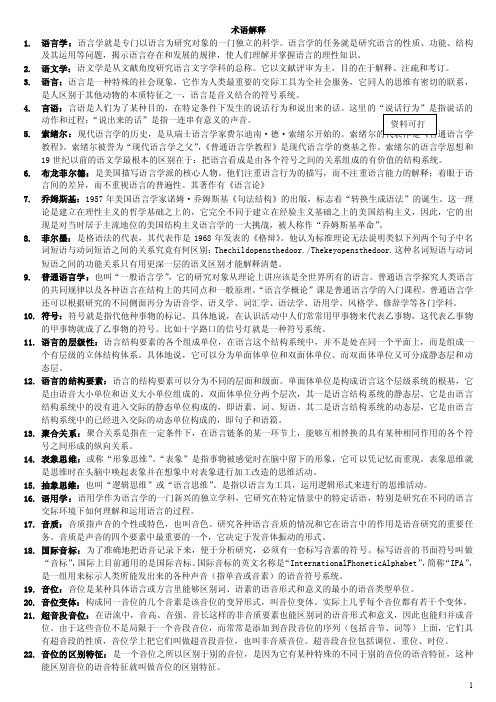
术语解释1.语言学:语言学就是专门以语言为研究对象的一门独立的科学。
语言学的任务就是研究语言的性质、功能、结构及其运用等问题,揭示语言存在和发展的规律,使人们理解并掌握语言的理性知识。
2.语文学:语文学是从文献角度研究语言文字学科的总称。
它以文献评审为主,目的在于解释、注疏和考订。
3.语言:语言是一种特殊的社会现象,它作为人类最重要的交际工具为全社会服务,它同人的思维有密切的联系,是人区别于其他动物的本质特征之一,语言是音义结合的符号系统。
4.言语:言语是人们为了某种目的,在特定条件下发生的说话行为和说出来的话。
这里的“说话行为”是指说话的5.索绪尔:教程》。
索绪尔被誉为“现代语言学之父”,《普通语言学教程》是现代语言学的奠基之作。
索绪尔的语言学思想和19世纪以前的语文学最根本的区别在于:把语言看成是由各个符号之间的关系组成的有价值的结构系统。
6.布龙菲尔德:是美国描写语言学派的核心人物。
他们注重语言行为的描写,而不注重语言能力的解释;着眼于语言间的差异,而不重视语言的普遍性。
其著作有《语言论》7.乔姆斯基:1957年美国语言学家诺姆·乔姆斯基《句法结构》的出版,标志着“转换生成语法”的诞生。
这一理论是建立在理性主义的哲学基础之上的,它完全不同于建立在经验主义基础之上的美国结构主义,因此,它的出现是对当时居于主流地位的美国结构主义语言学的一大挑战,被人称作“乔姆斯基革命”。
8.菲尔墨:是格语法的代表,其代表作是1968年发表的《格辩》。
他认为标准理论无法说明类似下列两个句子中名词短语与动词短语之间的关系究竟有何区别:Thechildopensthedoor./Thekeyopensthedoor.这种名词短语与动词短语之间的功能关系只有用更深一层的语义区别才能解释清楚。
9.普通语言学:也叫“一般语言学”,它的研究对象从理论上讲应该是全世界所有的语言。
普通语言学探究人类语言的共同规律以及各种语言在结构上的共同点和一般原理。
语言学知识点

语言学知识点语言学是一门研究语言的科学,它涉及到语言的结构、历史、发展、语音、语法、语义等多个方面。
本文将介绍一些重要的语言学知识点,帮助读者更好地理解语言的本质和运作方式。
一、语言的定义与特征语言是人类交流思想和感情的工具,它具有以下几个基本特征:1. 双重系统:语言包含语音和文字两个层面,通过语音传达信息,通过文字记录和传承。
2. 交流功能:语言是一种交流工具,用于表达思想、传递信息、交流感情等。
3. 语法系统:语言具有一定的语法规则和结构,用于组织词汇和句子,使其具有意义和逻辑性。
4. 文化载体:语言与文化密切相关,反映了不同文化背景下的人们的思维方式和价值观念。
二、语音学语音学是研究语音的学科,主要关注语音的产生、传播和感知。
以下是一些语音学的重要概念和知识点:1. 音素:语音学中最小的语音单位,不同语言中的音素数量和种类各不相同。
2. 语音合成:通过计算机技术模拟人类语音产生过程,生成人工语音。
3. 语音识别:通过计算机技术将语音转化为文字的过程,用于语音输入和语音翻译等应用。
三、语法学语法学是研究语言的结构和规则的学科,以下是一些语法学的重要知识点:1. 词类:语言中的词汇可以分为名词、动词、形容词、副词等不同的词类。
2. 句法:句法研究句子的结构和组成方式,包括句子成分、语序、句子类型等。
3. 句子的层次结构:句子可以分为短语、从句等不同的层次结构。
四、语义学语义学是研究语言意义的学科,以下是一些语义学的重要概念和知识点:1. 词汇语义:研究词汇的意义和词义关系,包括同义词、反义词、上下位关系等。
2. 句子语义:研究句子的意义和句义关系,包括逻辑关系、语用关系等。
3. 语义推理:通过语义规则和逻辑关系,推导出句子的隐含意义或推断结果。
五、语用学语用学是研究语言使用情境和交际目的的学科,以下是一些语用学的重要知识点:1. 言语行为:研究言语行为的目的和效果,包括陈述、疑问、命令等不同类型的言语行为。
什么是语言学
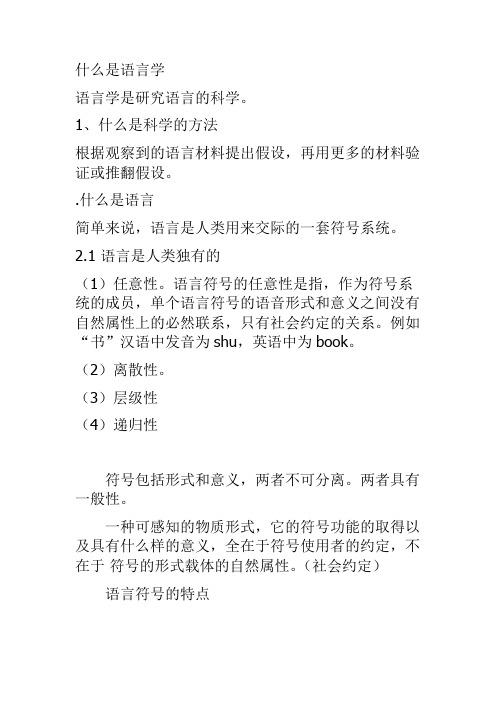
什么是语言学语言学是研究语言的科学。
1、什么是科学的方法根据观察到的语言材料提出假设,再用更多的材料验证或推翻假设。
.什么是语言简单来说,语言是人类用来交际的一套符号系统。
2.1 语言是人类独有的(1)任意性。
语言符号的任意性是指,作为符号系统的成员,单个语言符号的语音形式和意义之间没有自然属性上的必然联系,只有社会约定的关系。
例如“书”汉语中发音为shu,英语中为book。
(2)离散性。
(3)层级性(4)递归性符号包括形式和意义,两者不可分离。
两者具有一般性。
一种可感知的物质形式,它的符号功能的取得以及具有什么样的意义,全在于符号使用者的约定,不在于符号的形式载体的自然属性。
(社会约定)语言符号的特点(1)语言符号的任意性:语言符号的任意性是指,作为符号系统的成员,单个语言符号的语音形式和意义之间没有自然属性上的必然联系,只有社会约定的关系。
例如“书”汉语中发音为shu,英语中为book。
符号与征候(2)语言符号的线条性:语言符号在使用中以符号序列的形式出现,语言符号在时间中展开,线条性是语言符号分析的基础。
(3)语言符号的系统性:音系(音位)和语法(音素)两个层面。
分层语言的底层是一套音位,语言的上层是音义结合的符号和符号的序列,这一层又分为若干级。
第一级是语素,意义在这里被装进形式的口袋,成了音义结合的最小的符号。
第二级是由语素构成的词,第三级是由词构成的句子。
词和句子都是符号的序列。
语言符号的组合关系与聚合关系(1)组合关系是指语言单位线性组合时产生的相互关系。
P31音位的组合:/x//a//u/;语素的组合:语—言;词的组合:语言—类型;词组的组合:老师和同学共同研究语言学。
(2)聚合关系是语言单位按某些共同点相互联系的潜在关系。
例如“红花”红可以用白、紫、粉等代替,花可以用光、线、房子等代替,此时这两组词构成聚合。
语言与言语(1)言语即说话,是具体语言行为的结果。
(2)语言是说话依循的材料和规则。
语言学核心知识点

语言学核心知识点导言语言学是研究语言的科学,涉及语言的结构、发展、变化、习得等方面。
掌握语言学的核心知识点对于理解和分析语言现象至关重要。
本文将介绍一些重要的语言学核心知识点,以帮助读者深入了解语言学的基本概念和原理。
一、语音学语音学是研究语音系统的学科。
它关注的核心知识点包括音位、音位组合规则、音系、音变规律等。
音位是指语言中具有区别意义的最小语音单位。
不同语言的音位有所不同,比如英语中的/b/和/p/是不同的音位。
音位组合规则研究音位如何组合成词和句。
音系是指某一语言中所有的音位及其组合规则。
音变规律研究语言中音位的变化规律,比如英语中的/t/在单词结尾发音时可能变为/d/。
二、词汇学词汇学是研究词汇的学科。
它关注的核心知识点包括词的定义、构词法、词义、词汇网络等。
词是语言中的基本构成单位,具有一定的形式和意义。
构词法研究如何通过特定的规则构造新词。
词义研究词汇的意义和语境中的含义。
词汇网络研究词汇之间的关联和联系,比如同义词、反义词等。
三、句法学句法学是研究句子结构的学科。
它关注的核心知识点包括短语、句子成分、句子类型、句子结构等。
短语是指由几个词构成的有意义的单位,可以是名词短语、动词短语等。
句子成分研究句子中的各个组成部分,比如主语、谓语、宾语等。
句子类型研究不同类型的句子结构和语法规则,比如陈述句、疑问句等。
句子结构研究句子内部各个成分的排列顺序和关系。
四、语义学语义学是研究句子含义的学科。
它关注的核心知识点包括词义、句义、语用学等。
词义研究词的具体含义和义项,如形容词的描述性义和评价义。
句义研究句子的整体含义和逻辑关系,如假设、推理等。
语用学研究语言使用的上下文和交际功能,如言外之意、言外之意等。
五、语篇学语篇学是研究连续语言材料的学科。
它关注的核心知识点包括信息结构、语段、修辞学等。
信息结构研究语言材料的信息组织方式,如主题句和衔接词的使用。
语段研究语言材料的段落和篇章结构,如起承转合、总分结构等。
什么是语言学?为什么语言学对我们很重要?
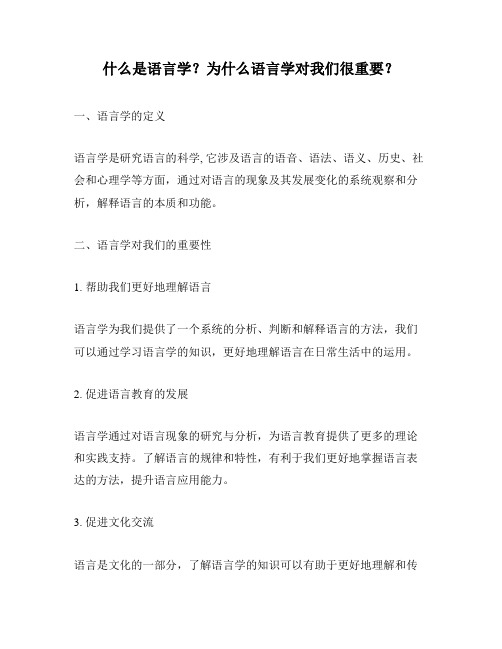
什么是语言学?为什么语言学对我们很重要?
一、语言学的定义
语言学是研究语言的科学, 它涉及语言的语音、语法、语义、历史、社会和心理学等方面,通过对语言的现象及其发展变化的系统观察和分析,解释语言的本质和功能。
二、语言学对我们的重要性
1. 帮助我们更好地理解语言
语言学为我们提供了一个系统的分析、判断和解释语言的方法,我们可以通过学习语言学的知识,更好地理解语言在日常生活中的运用。
2. 促进语言教育的发展
语言学通过对语言现象的研究与分析,为语言教育提供了更多的理论和实践支持。
了解语言的规律和特性,有利于我们更好地掌握语言表达的方法,提升语言应用能力。
3. 促进文化交流
语言是文化的一部分,了解语言学的知识可以有助于更好地理解和传
递文化信息。
通过对语言的学习和掌握,跨文化交流可以变得更加顺
畅和有效。
4. 帮助我们更好地理解自身与世界
语言是人类认知和交流的重要工具,在通过语言学学习语言的过程中,我们能够更深入地了解自身思考方式与认知图景,以及其他文化背景
的人的不同认知和交流方式。
5. 促进语言科技的发展
随着人工智能技术的发展,语言科技也逐渐成为科技行业的一个重要
领域。
语言学对于语音识别、自然语言处理、机器翻译等方面的发展
有着重要的贡献。
综上所述,语言学的学习不仅有助于我们提高语言应用能力,更能够
帮助我们更好地了解自身和他人之间的交流方式和文化特点,在多元
文化的今天具有非常重要的意义。
语言学名词解释
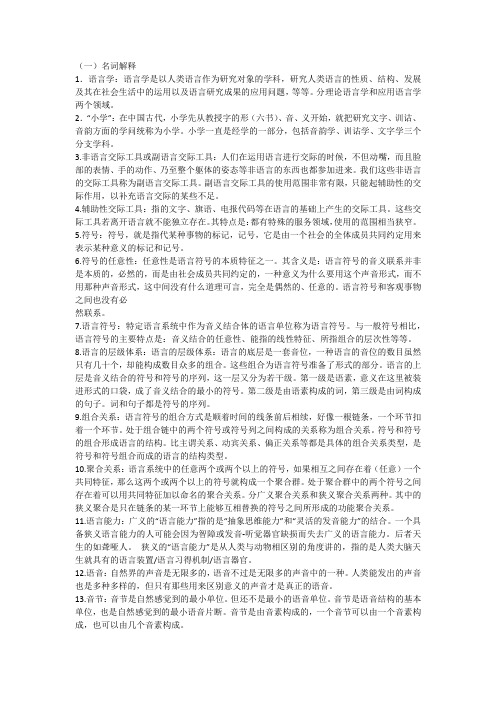
(一)名词解释1.语言学:语言学是以人类语言作为研究对象的学科,研究人类语言的性质、结构、发展及其在社会生活中的运用以及语言研究成果的应用问题,等等。
分理论语言学和应用语言学两个领域。
2.“小学”:在中国古代,小学先从教授字的形(六书)、音、义开始,就把研究文字、训诂、音韵方面的学问统称为小学。
小学一直是经学的一部分,包括音韵学、训诂学、文字学三个分支学科。
3.非语言交际工具或副语言交际工具:人们在运用语言进行交际的时候,不但动嘴,而且脸部的表情、手的动作、乃至整个躯体的姿态等非语言的东西也都参加进来。
我们这些非语言的交际工具称为副语言交际工具。
副语言交际工具的使用范围非常有限,只能起辅助性的交际作用,以补充语言交际的某些不足。
4.辅助性交际工具:指的文字、旗语、电报代码等在语言的基础上产生的交际工具。
这些交际工具若离开语言就不能独立存在。
其特点是:都有特殊的服务领域,使用的范围相当狭窄。
5.符号:符号,就是指代某种事物的标记,记号,它是由一个社会的全体成员共同约定用来表示某种意义的标记和记号。
6.符号的任意性:任意性是语言符号的本质特征之一。
其含义是:语言符号的音义联系并非是本质的,必然的,而是由社会成员共同约定的,一种意义为什么要用这个声音形式,而不用那种声音形式,这中间没有什么道理可言,完全是偶然的、任意的。
语言符号和客观事物之间也没有必然联系。
7.语言符号:特定语言系统中作为音义结合体的语言单位称为语言符号。
与一般符号相比,语言符号的主要特点是:音义结合的任意性、能指的线性特征、所指组合的层次性等等。
8.语言的层级体系:语言的层级体系:语言的底层是一套音位,一种语言的音位的数目虽然只有几十个,却能构成数目众多的组合。
这些组合为语言符号准备了形式的部分。
语言的上层是音义结合的符号和符号的序列,这一层又分为若干级。
第一级是语素,意义在这里被装进形式的口袋,成了音义结合的最小的符号。
第二级是由语素构成的词,第三级是由词构成的句子。
linguistics的分类
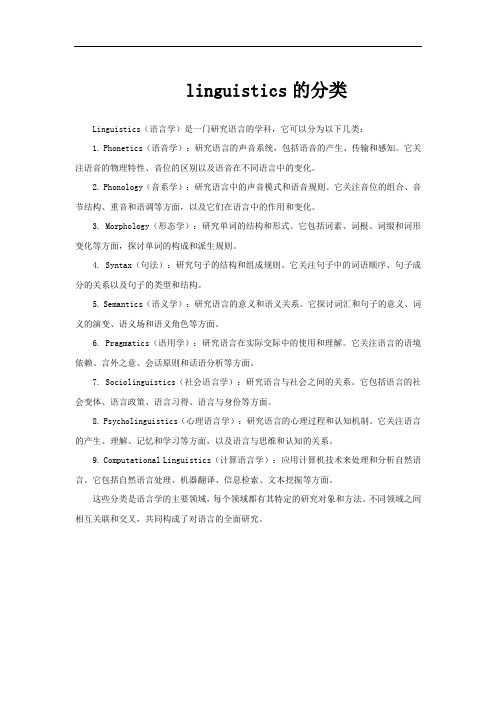
linguistics的分类Linguistics(语言学)是一门研究语言的学科,它可以分为以下几类:1. Phonetics(语音学):研究语言的声音系统,包括语音的产生、传输和感知。
它关注语音的物理特性、音位的区别以及语音在不同语言中的变化。
2. Phonology(音系学):研究语言中的声音模式和语音规则。
它关注音位的组合、音节结构、重音和语调等方面,以及它们在语言中的作用和变化。
3. Morphology(形态学):研究单词的结构和形式。
它包括词素、词根、词缀和词形变化等方面,探讨单词的构成和派生规则。
4. Syntax(句法):研究句子的结构和组成规则。
它关注句子中的词语顺序、句子成分的关系以及句子的类型和结构。
5. Semantics(语义学):研究语言的意义和语义关系。
它探讨词汇和句子的意义、词义的演变、语义场和语义角色等方面。
6. Pragmatics(语用学):研究语言在实际交际中的使用和理解。
它关注语言的语境依赖、言外之意、会话原则和话语分析等方面。
7. Sociolinguistics(社会语言学):研究语言与社会之间的关系。
它包括语言的社会变体、语言政策、语言习得、语言与身份等方面。
8. Psycholinguistics(心理语言学):研究语言的心理过程和认知机制。
它关注语言的产生、理解、记忆和学习等方面,以及语言与思维和认知的关系。
9. Computational Linguistics(计算语言学):应用计算机技术来处理和分析自然语言。
它包括自然语言处理、机器翻译、信息检索、文本挖掘等方面。
这些分类是语言学的主要领域,每个领域都有其特定的研究对象和方法。
不同领域之间相互关联和交叉,共同构成了对语言的全面研究。
语言学
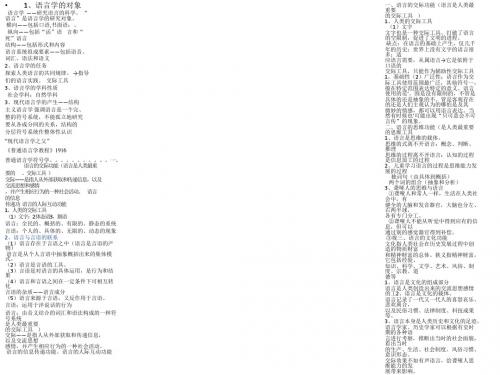
• • •
符号的特性 1)符号的任意性和约定性 ——符号的形式和意义之间的关系是任意的, 是由社会约定俗成的。
语流音变 • • 同化与异化 同化:两个不同或不相近的音连读,受 影响而变得相同 异化:两个原来相同或相近的音连读,受 影响而变得不相同或不相近 弱化和脱落 弱化:语流中有些音发音时受所处地位 (末尾、助词)的影响而引起的肌肉紧张 度减弱的音变现象 脱落:语流音变中连读的某个音消失的语 音现象。 汉语轻声音节经常出现脱落情况。 3)增音:语流中连读发音时音素增加的语 音现象。 三、语法单位 语素→词→词组→句子 构词语,素词根:多能单独构词 词缀: 不能单独构词 变词语素 词尾:只能在词尾改变词 形 2.词是可以独立运用的最小的语法单位 语言中最大的语法单位,交际时最小的使 用单位。 句子由词或词组构成,具有完整的语调。 词或词组一旦进入交际,就成为句子 单纯词:由一个词根语素构成的词。 天 他 吃 好 玻璃 巧克力 合成词:由两个或两个以上的构词语素组 成的词。 复合词:词根+词根 天 blackboard waterfall 派生词:词根+词缀 石头 national 词的组合的五种基本类型 语法结构 —— 语法关系 主谓结构——反映陈述对象(主语)和陈述 内容(谓语)的关系。今天/星期五。 述宾结构——反映动作(述语)和受动作支 配的事物(宾语)的关系。吃/苹果! 偏正结构——反映修饰和被修饰的关系。红 /苹果 联合结构——反映并列平等的关系。红/与 黑 述补结构——反映补充(补语)和被补充 (述语)的关系。红/起来了 他 去年 去 了 一趟 美国。 |__||___________________| 主谓结 构 |___||______________| 状中结构 |________| |__| 述宾结构 |_||___| 述补结构 形态1)附加法:-s、-ing(表动词进行体)、 -ed(表动词过去时); 内部屈折: man表示单数, men表示复数 异根法: we是主格,us是宾格 重叠个个;繁星点点 零形态:apple(表单数)——apples (表 复数)
什么是语言学
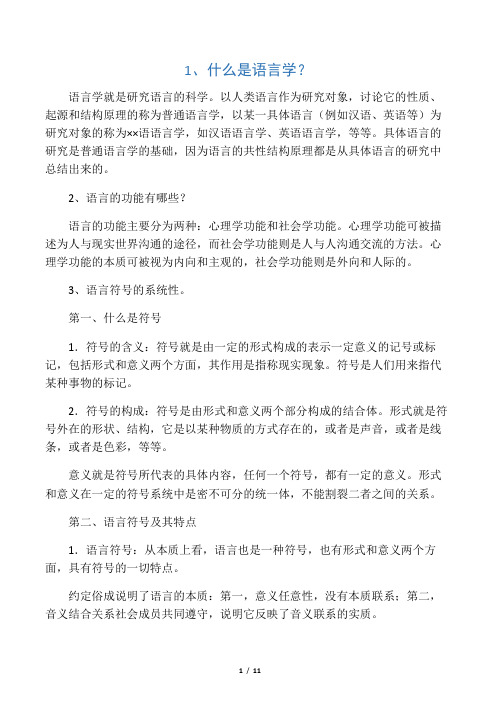
1、什么是语言学?语言学就是研究语言的科学。
以人类语言作为研究对象,讨论它的性质、起源和结构原理的称为普通语言学,以某一具体语言(例如汉语、英语等)为研究对象的称为××语语言学,如汉语语言学、英语语言学,等等。
具体语言的研究是普通语言学的基础,因为语言的共性结构原理都是从具体语言的研究中总结出来的。
2、语言的功能有哪些?语言的功能主要分为两种:心理学功能和社会学功能。
心理学功能可被描述为人与现实世界沟通的途径,而社会学功能则是人与人沟通交流的方法。
心理学功能的本质可被视为内向和主观的,社会学功能则是外向和人际的。
3、语言符号的系统性。
第一、什么是符号1.符号的含义:符号就是由一定的形式构成的表示一定意义的记号或标记,包括形式和意义两个方面,其作用是指称现实现象。
符号是人们用来指代某种事物的标记。
2.符号的构成:符号是由形式和意义两个部分构成的结合体。
形式就是符号外在的形状、结构,它是以某种物质的方式存在的,或者是声音,或者是线条,或者是色彩,等等。
意义就是符号所代表的具体内容,任何一个符号,都有一定的意义。
形式和意义在一定的符号系统中是密不可分的统一体,不能割裂二者之间的关系。
第二、语言符号及其特点1.语言符号:从本质上看,语言也是一种符号,也有形式和意义两个方面,具有符号的一切特点。
约定俗成说明了语言的本质:第一,意义任意性,没有本质联系;第二,音义结合关系社会成员共同遵守,说明它反映了音义联系的实质。
2.语言符号又不同于一般符号。
可从以下几个方面认识理解,首先,语言符号是声音和意义的结合体,是说的和听的;其次,一般符号的构成比较简单,而语言符号却是非常复杂的,可分不同的层级;再次,一般符号由于构造简单,因而只能表达有限的内容,而且这种内容是简单而固定的,语言符号则可以表达丰富多彩的意义;最后,语言符号具有以少驭多的生成机制,具有生成新的结构的能力,一般符号表达的意义是固定的,因而不能生成新的意义。
语言学知识点
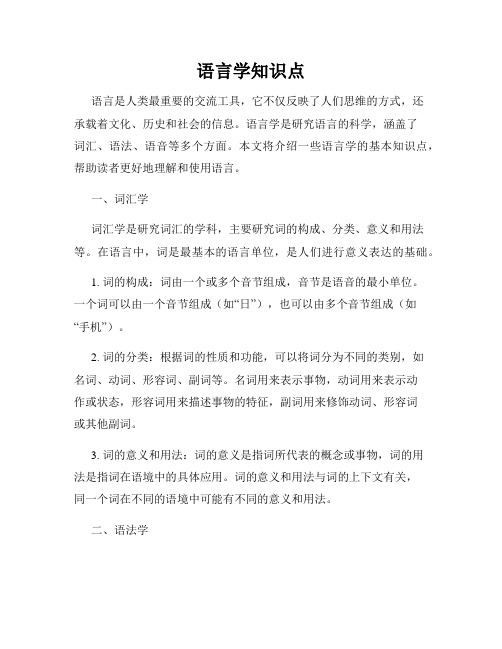
语言学知识点语言是人类最重要的交流工具,它不仅反映了人们思维的方式,还承载着文化、历史和社会的信息。
语言学是研究语言的科学,涵盖了词汇、语法、语音等多个方面。
本文将介绍一些语言学的基本知识点,帮助读者更好地理解和使用语言。
一、词汇学词汇学是研究词汇的学科,主要研究词的构成、分类、意义和用法等。
在语言中,词是最基本的语言单位,是人们进行意义表达的基础。
1. 词的构成:词由一个或多个音节组成,音节是语音的最小单位。
一个词可以由一个音节组成(如“日”),也可以由多个音节组成(如“手机”)。
2. 词的分类:根据词的性质和功能,可以将词分为不同的类别,如名词、动词、形容词、副词等。
名词用来表示事物,动词用来表示动作或状态,形容词用来描述事物的特征,副词用来修饰动词、形容词或其他副词。
3. 词的意义和用法:词的意义是指词所代表的概念或事物,词的用法是指词在语境中的具体应用。
词的意义和用法与词的上下文有关,同一个词在不同的语境中可能有不同的意义和用法。
二、语法学语法学是研究句子结构和句子之间关系的学科,主要研究句子的组成、句子成分的功能和语序等。
语法规定了语言的结构和组织方式,是语言表达的重要规范。
1. 句子结构:句子由词组合而成,词之间有一定的组织结构。
按照语法规则,句子可以分为主谓结构、主系表结构、主谓宾结构等不同的句子结构。
2. 句子成分:句子由一个或多个句子成分组成,句子成分包括主语、谓语、宾语、定语、状语等。
主语通常是进行动作的执行者,谓语表示动作或状态,宾语是动作的承受者或影响对象,定语和状语用来修饰名词或动词。
3. 语序:语序是指词或词组在句子中的排列顺序。
不同的语言有不同的语序规则,汉语的基本语序为主谓宾,但也可以根据需要进行灵活调整。
三、语音学语音学是研究语音的学科,主要研究语音的产生、传播和感知等。
语音是语言中最基本的声音单位,也是语言交流的基础。
1. 音素:音素是语言中最小的语音单位,用来区分词和词之间的差异。
语言学和语言文学
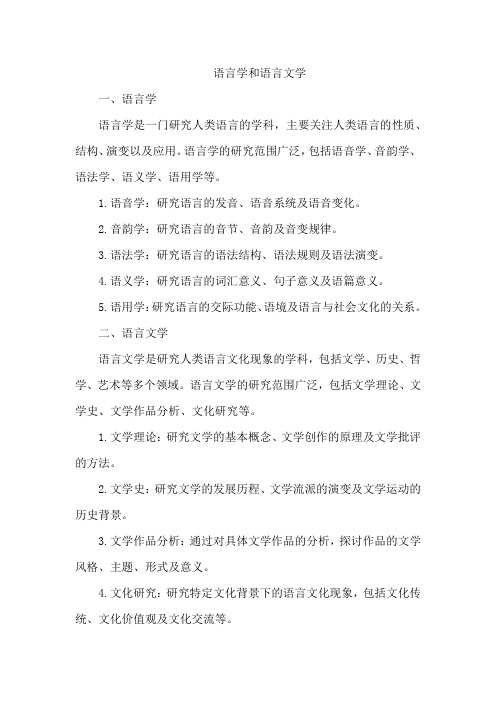
语言学和语言文学
一、语言学
语言学是一门研究人类语言的学科,主要关注人类语言的性质、结构、演变以及应用。
语言学的研究范围广泛,包括语音学、音韵学、语法学、语义学、语用学等。
1.语音学:研究语言的发音、语音系统及语音变化。
2.音韵学:研究语言的音节、音韵及音变规律。
3.语法学:研究语言的语法结构、语法规则及语法演变。
4.语义学:研究语言的词汇意义、句子意义及语篇意义。
5.语用学:研究语言的交际功能、语境及语言与社会文化的关系。
二、语言文学
语言文学是研究人类语言文化现象的学科,包括文学、历史、哲学、艺术等多个领域。
语言文学的研究范围广泛,包括文学理论、文学史、文学作品分析、文化研究等。
1.文学理论:研究文学的基本概念、文学创作的原理及文学批评的方法。
2.文学史:研究文学的发展历程、文学流派的演变及文学运动的历史背景。
3.文学作品分析:通过对具体文学作品的分析,探讨作品的文学风格、主题、形式及意义。
4.文化研究:研究特定文化背景下的语言文化现象,包括文化传统、文化价值观及文化交流等。
总之,语言学与语言文学是相互关联的学科,前者主要关注语言本身的研究,后者则更加关注语言与文化、历史的联系。
两者相辅相成,共同构成了人类语言文化的综合体系。
语言学理论名词解释
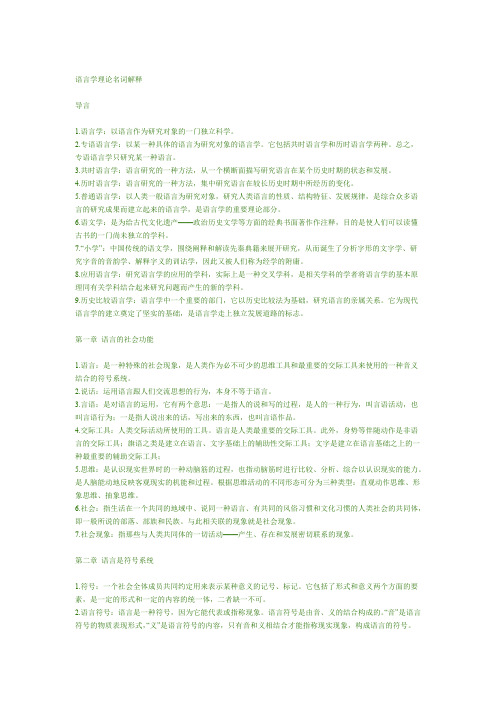
语言学理论名词解释导言1.语言学:以语言作为研究对象的一门独立科学。
2.专语语言学:以某一种具体的语言为研究对象的语言学。
它包括共时语言学和历时语言学两种。
总之,专语语言学只研究某一种语言。
3.共时语言学:语言研究的一种方法,从一个横断面描写研究语言在某个历史时期的状态和发展。
4.历时语言学:语言研究的一种方法,集中研究语言在较长历史时期中所经历的变化。
5.普通语言学:以人类一般语言为研究对象,研究人类语言的性质、结构特征、发展规律,是综合众多语言的研究成果而建立起来的语言学,是语言学的重要理论部分。
6.语文学:是为给古代文化遗产——政治历史文学等方面的经典书面著作作注释,目的是使人们可以读懂古书的一门尚未独立的学科。
7.“小学”:中国传统的语文学,围绕阐释和解读先秦典籍来展开研究,从而诞生了分析字形的文字学、研究字音的音韵学、解释字义的训诂学,因此又被人们称为经学的附庸。
8.应用语言学:研究语言学的应用的学科,实际上是一种交叉学科,是相关学科的学者将语言学的基本原理同有关学科结合起来研究问题而产生的新的学科。
9.历史比较语言学:语言学中一个重要的部门,它以历史比较法为基础,研究语言的亲属关系。
它为现代语言学的建立奠定了坚实的基础,是语言学走上独立发展道路的标志。
第一章语言的社会功能1.语言:是一种特殊的社会现象,是人类作为必不可少的思维工具和最重要的交际工具来使用的一种音义结合的符号系统。
2.说话:运用语言跟人们交流思想的行为,本身不等于语言。
3.言语:是对语言的运用,它有两个意思:一是指人的说和写的过程,是人的一种行为,叫言语活动,也叫言语行为;一是指人说出来的话,写出来的东西,也叫言语作品。
4.交际工具:人类交际活动所使用的工具。
语言是人类最重要的交际工具。
此外,身势等伴随动作是非语言的交际工具;旗语之类是建立在语言、文字基础上的辅助性交际工具;文字是建立在语言基础之上的一种最重要的辅助交际工具;5.思维:是认识现实世界时的一种动脑筋的过程,也指动脑筋时进行比较、分析、综合以认识现实的能力。
语言学的主要流派
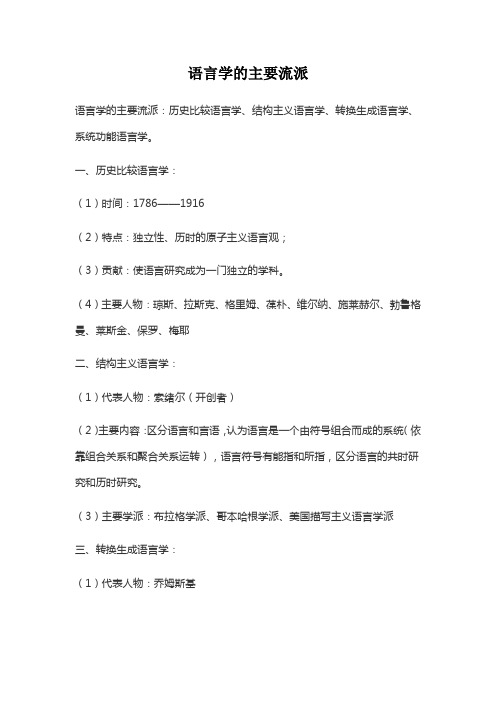
语言学的主要流派
语言学的主要流派:历史比较语言学、结构主义语言学、转换生成语言学、系统功能语言学。
一、历史比较语言学:
(1)时间:1786——1916
(2)特点:独立性、历时的原子主义语言观;
(3)贡献:使语言研究成为一门独立的学科。
(4)主要人物:琼斯、拉斯克、格里姆、葆朴、维尔纳、施莱赫尔、勃鲁格曼、莱斯金、保罗、梅耶
二、结构主义语言学:
(1)代表人物:索绪尔(开创者)
(2)主要内容:区分语言和言语,认为语言是一个由符号组合而成的系统(依靠组合关系和聚合关系运转),语言符号有能指和所指,区分语言的共时研究和历时研究。
(3)主要学派:布拉格学派、哥本哈根学派、美国描写主义语言学派三、转换生成语言学:
(1)代表人物:乔姆斯基
(2)大致内容:采用现代数理逻辑的形式化方法,根据有限规则演绎无限的句子。
四、系统功能语言学
(1)代表人物:韩礼德
(2)主要内容:重视语言在社会学上的特征,研究如何根据特定交际目的选择特定的语句,集中力量发现描写语言在社会中的规律;从认知的角度解释语言现象;注重个别语言以及个别变体的描写,发现语句在社会中的规律。
语言学专业学什么
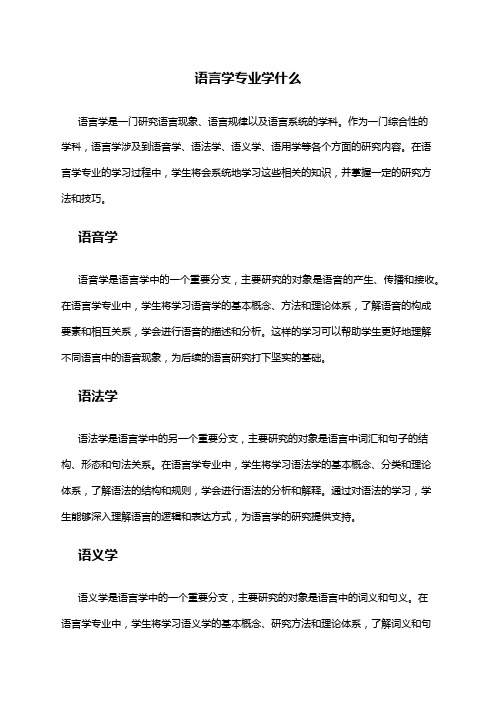
语言学专业学什么语言学是一门研究语言现象、语言规律以及语言系统的学科。
作为一门综合性的学科,语言学涉及到语音学、语法学、语义学、语用学等各个方面的研究内容。
在语言学专业的学习过程中,学生将会系统地学习这些相关的知识,并掌握一定的研究方法和技巧。
语音学语音学是语言学中的一个重要分支,主要研究的对象是语音的产生、传播和接收。
在语言学专业中,学生将学习语音学的基本概念、方法和理论体系,了解语音的构成要素和相互关系,学会进行语音的描述和分析。
这样的学习可以帮助学生更好地理解不同语言中的语音现象,为后续的语言研究打下坚实的基础。
语法学语法学是语言学中的另一个重要分支,主要研究的对象是语言中词汇和句子的结构、形态和句法关系。
在语言学专业中,学生将学习语法学的基本概念、分类和理论体系,了解语法的结构和规则,学会进行语法的分析和解释。
通过对语法的学习,学生能够深入理解语言的逻辑和表达方式,为语言学的研究提供支持。
语义学语义学是语言学中的一个重要分支,主要研究的对象是语言中的词义和句义。
在语言学专业中,学生将学习语义学的基本概念、研究方法和理论体系,了解词义和句义的构成要素和变化规律,学会进行语义的分析和解释。
通过对语义学的学习,学生能够深入理解语言的意义和表达方式,为语言的理解和翻译提供支持。
语用学语用学是语言学中的一个重要分支,主要研究的对象是语言使用的背景和效果。
在语言学专业中,学生将学习语用学的基本概念、研究方法和理论体系,了解语言使用的情境和目的,学会进行语用的分析和解释。
通过对语用学的学习,学生能够更好地理解语言的交际和语言学习的实际应用。
其他相关学科除了以上几个主要的学科内容外,语言学专业还涉及到其他一些相关的学科,比如社会语言学、历史语言学、心理语言学等。
这些学科都对语言学的研究和应用提供了不同的视角和方法,丰富了语言学专业的学习内容。
总的来说,语言学专业的学习内容广泛且丰富,学生将会在语音学、语法学、语义学、语用学等方面进行系统的学习和训练。
- 1、下载文档前请自行甄别文档内容的完整性,平台不提供额外的编辑、内容补充、找答案等附加服务。
- 2、"仅部分预览"的文档,不可在线预览部分如存在完整性等问题,可反馈申请退款(可完整预览的文档不适用该条件!)。
- 3、如文档侵犯您的权益,请联系客服反馈,我们会尽快为您处理(人工客服工作时间:9:00-18:30)。
《语言学教程》重难点学习提示第一章语言的性质语言的定义:语言的基本特征(任意性、二重性、多产性、移位、文化传递和互换性);语言的功能(寒暄、指令、提供信息、询问、表达主观感情、唤起对方的感情和言语行为);语言的起源(神授说,人造说,进化说)等。
第二章语言学语言学定义;研究语言的四大原则(穷尽、一致、简洁、客观);语言学的基本概念(口语与书面语、共时与历时、语言与言学、语言能力与言行运用、语言潜势与语言行为);普通语言学的分支(语音、音位、语法、句法、语义);;语言学的应用(语言学与语言教学、语言与社会、语言与文字、语言与心理学、人类语言学、神经语言学、数理语言学、计算语言学)等。
第三章语音学发音器官的英文名称;英语辅音的发音部位和发音方法;语音学的定义;发音语音学;听觉语音学;声学语音学;元音及辅音的分类;严式与宽式标音等。
第四章音位学音位理论;最小对立体;自由变异;互补分布;语音的相似性;区别性特征;超语段音位学;音节;重音(词重音、句子重音、音高和语调)等。
第五章词法学词法的定义;曲折词与派生词;构词法(合成与派生);词素的定义;词素变体;自由词素;粘着词素(词根,词缀和词干)等。
第六章词汇学词的定义;语法词与词汇词;变词与不变词;封闭词与开放词;词的辨认;习语与搭配。
第七章句法句法的定义;句法关系;结构;成分;直接成分分析法;并列结构与从属结构;句子成分;范畴(性,数,格);一致;短语,从句,句子扩展等。
第八章语义学语义的定义;语义的有关理论;意义种类(传统、功能、语用);里奇的语义分类;词汇意义关系(同义、反义、下义);句子语义关系。
第九章语言变化语言的发展变化(词汇变化、语音书写文字、语法变化、语义变化);第十章语言、思维与文化语言与文化的定义;萨丕尔-沃夫假说;语言与思维的关系;语言与文化的关系;中西文化的异同。
第十一章语用学语用学的定义;语义学与语用学的区别;语境与意义;言语行为理论(言内行为、言外行为和言后行为);合作原则。
1.1. What is language?“Language is system of arbitrary vocal symbols used for human communication. It is a system, since linguistic elements are arranged systematically, rather than randomly. Arbitrary, in the sense that there is usually no intrinsic connection between a work (like “book”) and the object it refersto. This explains and is explained by the fact that different langu ages have different “books”: “book” in English, “livre” in French, in Japanese, in Chinese, “check” in Korean. It is symbolic, because words are associated with objects, actions, ideas etc. by nothing but convention. Namely, people use the sounds or vocal forms to symbolize what they wish to refer to. It is vocal, because sound or speech is the primary medium for all human languages, developed or “new”. Writing systems came much later than the spoken forms. The fact that small children learn and can only learn to speak (and listen) before they write (and read) also indicates that language is primarily vocal, rather than written. The term “human” in the definition is meant to specify that language is human specific.1.2. What are design features of language?“Design features” here refer to the defining properties of human language that tell the difference between human language and any system of animal communication. They are arbitrariness, duality, productivity, displacement, cultural transmission and interchangeability1.3. What is arbitrariness?By “arbitrariness”, we mean there is no logical connection between meanings and sounds (see I .1).A dog might be a pig if only the first person or group of persons had used it for a pig. Language is therefore largely arbitrary. But language is not absolutely seem to be some sound-meaning association, if we think of echo words, like “bang”, “crash”, “roar”, which are motivated in a certain sense. Secondly, some compounds (words compounded to be one word ) are not entirely arbitrary either. “Type” and “write” are opaque or unmotivated words, while “type-writer” is less so, or more transparent or motivated than the words that make it. So we can say “arbitrariness” is a matter of degree.1.4.What is duality?Ling uists refer “duality” (of structure) to the fact that in all languages so far investigated, one finds two levels of structure or patterning. At the first, higher level, language is analyzed in terms of combinations of meaningful units (such as morphemes, words etc.) ; at the second, lower level, it is seen as a sequence of segments which lack any meaning in themselves, but which combine to form units of meaning. According to Hu Zhanglin et al. (p.6) , language is a system of two sets of structures, one of sounds and the other of meaning. This is important for the workings of language.A small number of semantic units (words), and these units of meaning can be arranged and rearranged into an infinite number of sentences (note that we have dictionaries of words, but no dictionary of sentences!). Duality makes it possible for a person to talk about anything within his knowledge. No animal communication system enjoys this duality, or even approaches this honour.1.5.What is productivity?Productivity refers to the ability to the ability to construct and understand an indefinitely large number of sentences in one‟s native language, including those that has never heard before, but that are appropriate to the speaking situation. No one has ever said or heard “A re d-eyed elephant is dancing on the small hotel bed with an African gibbon”, but he can say it when necessary, and he can understand it in right register. Different from artistic creativity, though, productivity never goes outside the language, thus also cal led “rule-bound creativity” (by N.Chomsky).1.6.What is displacement?“Displacement”, as one of the design features of the human language, refers to the fact that one can talk about things that are not present, as easily as he does things present. In other words, one can refer to real and unreal things, things of the past, of the present, of the future. Language itself can be talked about too. When a man, for example, is crying to a woman, about something, it might be something that had occurred, or something that is occurring, or something that is to occur. When a dog is barking, however, you can decide it is barking for something or at someone that exists now and there. It couldn‟t be bow-wowing sorrowfully for dome lost love or a bone to be lost. The b ee‟s system, nonetheless, has a small share of “displacement”, but it is an unspeakable tiny share.1.7.What is cultural transmission?This means that language is not biologically transmitted from generation to generation, but that the details of the linguistic system must be learned anew by each speaker. It is true that the capacity for language in human beings(N. Chomsky called it “language acquisition device”, or LAD) has a genetic basis, but the particular language a person learns to speak is a cultural one other than a genetic one like the dog‟s barking system. If a human being is brought up in isolation he cannot acquire language. The Wolf Child reared by the pack of wolves turned out to speak the wolf‟s roaring “tongue” when he was saved. He learne d thereafter, with no small difficulty, the ABC of a certain human language.1.8.What is interchangeability?Interchangeability means that any human being can be both a producer and a receiver of messages. We can say, and on other occasions can receive and understand, for example, “Please do something to make me happy.” Though some people (including me) suggest that there is sex differentiation in the actual language use, in other words, men and women may say different things, yet in principle there is no sound, or word or sentence that a man can utter and a woman cannot, or vice versa. On the other hand, a person can be the speaker while the other person is the listener and as the turn moves on to the listener, he can be the speaker and the first speaker is to listen. It is turn-taking that makes social communication possible and acceptable.Some male birds, however, utter some calls which females do not (or cannot?) , and certain kinds of fish have similar haps mentionable. When a dog barks, all the neighbouring dogs bark. Then people around can hardly tell which dog (dogs) is (are0 “speaking” and which listening.1.9.Why do linguists say language is human specific?First of all, human language has six “design features” which animal communication syst ems do not have, at least not in the true sense of them(see I .2-8). Let‟s borrow C. F. Hocket‟s Chart that compares human language with some animals‟ systems, from Wang Gang(1998,p.8).Secondly, linguists have done a lot trying to teach animals such as chimpanzees to speak a human language but have achieved nothing inspiring. Washoe, a female chimpanzee, was brought up like a human child by Beatnice and Alan Gardner. She was taught “American sign Language”, and learned a little that made the teachers happy but did mot make the linguistics circle happy, for fewbelieved in teaching chimpanzees.Thirdly, a human child reared among animals cannot speak a human language, not even when he is taken back and taught to lo to so (see the “Wolf Child”in I.7)1.10.What functions does language have?Language has at least seven functions: phatic, directive, Informative, interrogative, expressive, evocative and performative. According to Wang Gang (1988,p.11), language has three main functions: a tool of communication, a tool whereby people learn about the world, and a tool by which people learn about the world, and a tool by which people create art . M .A. K.Halliday, representative of the London school, recognizes three “Macro-Functions”: ideational, interpersonal and textual(see !.11-17;see HU Zhuanglin et al.,pp10-13,pp394-396). 1. 11What is the phatic function?The “phatic function” refers to language being used for setting up a certain atmosphere or maintaining social contacts(rather than for exchanging information or ideas). Greetings, farewells, and comments on the weather in English and on clothing in Chinese all serve this function. Much of the phatic language (e.g. “How are you?” “Fine, thanks.”) is insincere if taken literally, but it is important. If you don't say “Hello” to a friend you meet, or if you don‟t answer his “Hi”, you ruin your friendship.1.12. What is the directive function?The “directive function” means that language may be used to get the hearer to do something. Most imperative sentence s perform this function, e. g., “Tell me the result when you finish.” Other syntactic structures or sentences of other sorts can, according to J.Austin and J.Searle‟s “indrect speech act theory”(see Hu Zhuanglin et al.,pp271-278) at least, serve the purpose of direction too, e.g., “If I were you, I would have blushed to the bottom of my ears!”1.13.What is the informative function?Language serves an “informational function” when used to tell something, characterized by the use of declarative sentences. Informative statements are often labelled as true(truth) or false(falsehood). According to P.Grice‟s “Cooperative Principle”(see Hu Zhuanglin et al., pp282-283), one ought not to violate the “Maxim of Quality”, when he is informing at all.1.14.What is the interrogative function?When language is used to obtain information, it serves an “interrogative function”. This includes all questions that expect replies, statements, imperatives etc., according to the “indirect speech act theory”, may have this function as well, e.g., “I‟d like to know you better.” This may bring forth a lot of personal information. Note that rhetorical questions make an exception, since they demand no answer, at least not the reader‟s/listener‟s answer.1.15.What is the expressive function?The “expressive function” is the use of language to reveal something about the feelings or attitudes of the speaker. Subconscious emotional ejaculations are good examples, like “Good heavens!” “My God!” Sentences like “I‟m sorry about the delay” can serve as good examples too, though in a subtle way. While language is used for the informative function to pass judgement onthe truth or falsehood of statements, language used for the expressive function evaluates, appraises or asserts the speaker‟s own attitudes.1.16.What is the evocative function?The “evocative function” is the use of language to create certain feelings in the hearer. Its aim is , for example, to amuse, startle, antagonize, soothe, worry or please. Jokes(not practical jokes, though) are supposed to amuse or entertain the listener; advertising to urge customers to purchase certain commodities; propaganda to influence public opinion. Obviously, the expressive and the evocative functions often go together, i.e., you may express, for example, your personal feelings about a political issue but end up by evoking the same feeling in, or imposing it on, your listener. That‟s also the case with the other way round.1.17.What is the performative function?This means people speak to “do things” or perform actions. On certain occasions the utterance itself as an action is more important than what words or sounds constitute the uttered sentence. When asked if a third Y angtze bridge ought to be built in Wuhan, the mayor may say “OK”, which means more than speech, and more than an average social individual may do for the construction. The judge‟s imprisonment sentence, the president‟s war or independence declaration, etc., are performatives as well(see J.Austin‟s speech Act Theory, Hu Zhuangl in, ecal.,pp271-278).1.18.What is linguistics?“Linguistics” is the scientific study of language. It studies not just one language of any one society, but the language of all human beings. A linguist, though, does not have to know and use a large number of languages, but to investigate how each language is constructed. He is also concerned with how a language varies from dialect to dialect, from class to class, how it changes from century to century, how children acquire their mother tongue, and perhaps how a person learns or should learn a foreign language. In short, linguistics studies the general principles whereupon all human languages are constructed and operate as systems of communication in their societies or communities (see Hu Zhuanglin et al.,pp20-22)1.19.What makes linguistics a science?Since linguistics is the scientific study of language, it ought to base itself upon the systematic, investigation of language data which aims at discovering the true nature of language and its underlying system. To make sense of the data, a linguist usually has conceived some hypotheses about the language structure, to be checked against the observed or observable facts. In order to make his analysis scientific, a linguist is usually guided by four principles: exhaustiveness, consistency, and objectivity. Exhaustiveness means he should gather all the materials relevant to the study and give them an adequate explanation, in spite of the complicatedness. He is to leave no linguistic “stone” unturned. Consistenc y means there should be no contradiction between different parts of the total statement. Economy means a linguist should pursue brevity in the analysis when it is possible. Objectivity implies that since some people may be subjective in the study, a linguist should be (or sound at least) objective, matter-of-face, faithful to reality, so that his work constitutes part of the linguistics research.1.20.What are the major branches of linguistics?The study of language as a whole is often called general linguistics (e.g.Hu Zhuanglin et al.,1988;Wang Gang,1988).But a linguist sometimes is able to deal with only one aspect of language at a time, thus the arise of various branches : phonetics ,phonology ,morphology, syntax, semantics, sociolinguistics, applied linguistics, pragmatics, psycholinguistics, lexicology, lexicography, etymology, etc.1.21.What are synchronic and diachronic studies?The description of a language at some point of time (as if it stopped developing) is a synchrony study (synchrony). The description of a language as it changes through time is a diachronic study (diachronic). An essay entitled “On the Use of THE”, for example, may be synchronic, if the author does not recall the past of THE, and it may also be diachronic if he claims to c over a large range or period of time wherein THE has undergone tremendous alteration (see Hu Zhuanglin et al.,pp25-27).1.22.What is speech and what is writing?No one needs the repetition of the general principle of linguistic analysis, namely, the primacy of speech over writing. Speech is primary, because it existed long long before writing systems came into being. Genetically children learn to speak before learning to write. Secondly, written forms just represent in this way or that the speech sounds : individual sounds, as in English and French as in Japanese.In contrast to speech, spoken form of language, writing as written codes, gives language new scope and use that speech does not have. Firstly, messages can be carried through space so that people can write to each other. Secondly, messages can be carried through time thereby, so that people of our time can be carried through time thereby, so that people of our time can read Beowulf, Samuel Johnson, and Edgar A. Poe. Thirdly, oral messages are readily subject to distortion, either intentional or unintentional (causing misunderstanding or malentendu), while written messages allow and encourage repeated unalterable reading. Most modern linguistic analysis is focused on speech, different from grammarians of the last century and theretofore.1.23.What are the differences between the descriptive and the prescriptive approaches?A linguistic study is “descriptive” if it only describes and analyses the facts of language, and “prescriptive” if it tries to lay down rules for “correct” language behavior. Linguistic studies before this century were largely prescriptive because many early grammars were largely prescriptive because many early grammars were based on “high” (literary or religious) written records. Modern linguistics is mostly descriptive, however. It (the latter) believes that whatever occurs in natural speech (hesitation, incomplete utterance, misunderstanding, etc.) should be described in the analysis, and not be marked as incorrect, abnormal, corrupt, or lousy. These, with changes in vocabulary and structures, need to be explained also.1.24.What is the difference between langue and parole?F. de Saussure refers “langue”to the abstract linguistic system shared by all the members of a speec h community and refers “parole” to the actual or actualized language, or the realization oflangue. Langue is abstract, parole specific to the speaking situation; langue not actually spoken by an individual, parole always a naturally occurring event; langue relatively stable and systematic, parole is a mass of confused facts, thus not suitable for systematic investigation. What a linguist ought to do, according to Saussure, is to abstract langue from instances of parole, i. e. to discover the regularities governing all instances of parole and make than the subject of linguistics. The langue-parole distinction is of great importance, which casts great influence on later linguists.1.25.What is the difference between competence and performance?According to N. Chomsky, “competence” is the ideal language user‟s knowledge of the rules of his language, and “performance” is the actual realization of this knowledge in utterances. The former enables a speaker to produce and understand an indefinite number of sentences and to recognize grammatical mistakes and ambiguities. A speaker‟s competence is stable while his performance is often influenced by psychological and social factors. So a speaker‟s performance does not always match or equal his supposed competence.Chomsky believes that linguists ought to study competence, rather than performance. In other words, they should discover what an ideal speaker knows of his native language.Chomsky‟s competence-performance distinction is not exactly the same as , though similar to , F. de Saussure‟s langue-parole distinction. Langue is a social product, and a set of conventions for a community, while competence is deemed as a property of the mind of each individual. Sussure looks at language more from a sociological or sociolinguistic point of view than N. Chomsky since the latter deals with his issues psychologically or psycholinguistically.1.26.What is linguistic potential? What is actual linguistic behaviour?These two terms, or the potential-behavior distinction, were made by M. A. K. Halliday in the 1960s, from a functional point of view. There is a wide range of things a speaker can do in his culture, and similarly there are many things he can say, for example, to many people, on many topics. What he actually says (i.e. his “actual linguistic behavior”) on a certain occasion to a certain person is what he has chosen from many possible injustice items, each of which he could have said (linguistic potential).1.27.In what way do language, competence and linguistic potential agree? In what way do they differ? And their counterparts?Langue, competence and linguistic potential have some similar features, but they are innately different (see 1.25). Langue is a social product, and a set of speaking conventions; competence is a property or attribute of each ideal speaker‟s mind; linguistic potential is all the linguistic corpus or repertoire available from which the speaker chooses items for the actual utterance situation. In other words, langue is invisible but reliable abstract system. Competence means “knowing”, and linguistic potential a set of possibilities for “doing” or “performing actions”. They are similar in that they all refer to the constant underlying the utterances that constitute what Saussure, Chomsky and Halliday respectively called parole, performance and actual linguistic behavior. Paole, performance and actual linguistic behavior enjoy more similarities than differences.1.28.What is phonetics?“Phonetics” is the science which studies the characterist ics of human sound-making, especiallythose sounds used in speech, and provides methods for their description, classification and transcription (see Hu Zhuanglin et al., pp39-40), speech sounds may be studied in different ways, thus by three different branches of phonetics. (1)Articulatory phonetics; the branch of phonetics that examines the way in which a speech sound is produced to discover which vocal organs are involved and how they coordinate in the process. (2)Auditory phonetics, the branch of phonetic research from the hearer‟s point of view, looking into the impression which a speech sound makes on the hearer as mediated by the ear , the auditory nerve and the brain. (3)Acoustic phonetics: the study of the physical properties of speech sounds, as transmitted between mouth and ear.Most phoneticians, however, are interested in articulatory phonetics.1.29.How are the vocal organs formed?The vocal organs (see Figure1, Hu Zhuanglin et al.,p41), or speech organs, are organs of the human body whose secondary use is in the production of speech sounds. The vocal organs can be considered as consisting of three parts; the initiator of the air-stream, the producer of voice and the resonating cavities.1.30.What is place of articulation?It refers to the place in the mouth where, for example, the obstruction occurs, resulting in the utterance of a consonant. Whatever sound is pronounced, at least some vocal organs will get involved,e. g. lips, hard palate etc., so a consonant may be one of the following (1 )bilabial p,b,m];(2) labiodental f,v]; (3) dental ,]; (4) alveolar t,d,l,n.s,z]; (5) retroflex; (6) palato-alveolar ,]; (7) palatal j]; (8) velar[k,g,]; (9) uvular; (10)glottal h].Some sounds involve the simultaneous use of two places of articulation. For example, the English [w]has both an approximation of the two lips and that two lips and that of the tongue and the soft palate, and may be termed “labial-velar”.1.31.What is the manner of articulation?The “manner of articulation” literally means the way a sound is articulated. At a given place of articulation, the airstream may be obstructed in various ways, resulting in various manners of articulation, are the following : (1) plosive p,b,t,d,k,g]; (2) nasal m,n,]; (3) trill; (4) tap or flap; (5) lateral l]; (6) fricative f,v,s,z]; (7) approximant w,j]; (8) affricate ].1.32.How do phoneticians classify vowels?Phoneticians, in spite of the difficulty, group vowels in 5 types: (1) long and short vowels, e.g.,[i:,];(4) rounded and unround vowels,e.g.[,i]; (5) pure and gliding vowels, e.g.[I,].1.33.What is IPA? When did it come into being ?The IPA, abbreviation of “International Phonetic Alphabet”, is a compromise system making use of symbols of all sources, including diacritics indicating length, stress and intonation, indicating phonetic variation. Ever since it was developed in 1888, IPA has undergone a number of revisions.1.34.What is narrow transcription and what is broad transcription?In handbook of phonetics, Henry Sweet made a dis tinction between “narrow” and “broad”transcriptions, which he called “Narrow Romic”. The former was meant to symbolize all the possible speech sounds, including even the most minute shades of pronunciation while Broad Romic or transcription was intended to indicate only those sounds capable of distinguishing one word from another in a given language.1.35.What is phonology? What is difference between phonetics and phonology?(1) “Phonology” is the study of sound systems- the invention of distinctive speech sounds that occur in a language and the patterns wherein they fall. Minimal pair, phonemes, allophones, free variation, complementary distribution, etc., are all to be investigated by a phonologist.(2) Phonetics, as discussed in I.28, is the branch of linguistics studying the characteristics of speech sounds and provides methods for their description, classification and transcription. A phonetist is mainly interested in the physical properties of the speech sounds, whereas a phonologist studies what he believes are meaningful sounds related with their semantic features, morphological features, and the way they are conceived and printed in the depth of the mind phonological knowledge permits a speaker to produce sounds which from meaningful utterances, to recognize a foreign “accent”, to make up new words, to add the appropriate phonetic segments to from plurals and past tenses, to know what is and what is not a sound in one‟s language.1.36.What is a phone? What is a phoneme? What is an allophone?A“phone” is a phonetic unit or segment. The speech sounds we hear and produce during linguistic communication are all phones. When we hear the following words pronounced pit], [tip], [spit], etc., the similar phones we have heard are [p] for one thing, and three different[p]‟s, readily making possible the “narrow transcription or diacritics”. Phones may and may not distinguish meaning. A “phoneme” is a phonological unit; it is a unit that is of distinctive value. As an abstract unit, a phoneme is not any particular sound, but rather it is represented or realized by a certain phone in a certain phonetic context. For example, the phoneme[p] is represented differently in [pit], [tip] and [spit].The phones representing a phoneme are called its “allophones”, i. e., the different (i.e., phones) but do not make one word so phonetically different as to create a new word or a new meaning thereof. So the different[p]‟s in the above words are the allophones of the same phoneme[p]. How a phoneme is represented by a phone, or which allophone is to be used, is determined by the phonetic context in which it occurs. But the choice of an allophone is not random. In most cases it is rule-governed; these rules are to be found out by a phonologist.1.37.What are minimal pairs?When two different phonetic forms are identical in every way except for one sound segment which occurs in the same place in the string , the two forms(i. e., word) are supposed to form a “minimal pair”, e.g., “pill” and “bill”, “pill” and “till”, “till” and “dill”, “till” and “kill”, etc. All these words together constitute a minimal set. They are identical in form except for the initial consonants. There are many minimal pairs in English, which makes it relatively easy to know what are English phonemes. It is of great importance to find the minimal pairs when a phonologist is dealing with the sound system of an unknown language(see Hu Zhuanglin et al., pp65-66).1.38.What is free variation?。
